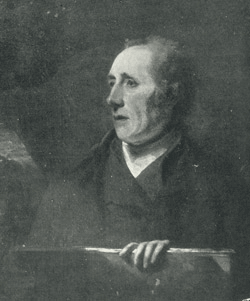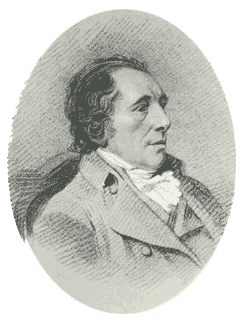William Ashford, Landscape Painter
(b. 1746, d. 1824)
Landscape Painter
From A Dictionary of Irish Artists 1913

William Ashford. Portrait painted by William Cuming, P.R.H.A.; in the Royal Hibernian Academy.
Was born in Birmingham in 1746. He came to Ireland in 1764 and settled in Dublin, having obtained an appointment in the Ordnance Office through the interest of the Surveyor-General, Ralph Ward. It is not known where he learned his art; but in 1767, within three years of his arrival in Dublin, he appeared as an exhibitor at the Society of Artists in William Street, sending from Aston's Quay two flower-pieces in oil. His next appearance was in 1770, when, from his lodgings at "the Indian Queen in Dame Street," he sent pictures of fruit and dead game; and he exhibited similar subjects in the following year. In the exhibition of 1772 he first showed his powers as a landscape painter, and one of the three pictures he exhibited was awarded the Dublin Society's second premium, Thomas Roberts (q.v.) gaining the first. In the following year, 1773, he won the first premium. He continued as a regular contributor to the Society of Artists down to 1780, among his pictures being "A View of Dawson's Grove," 1774; three "Views of Moore Abbey," 1775; a "View of Chapelizod," 1777, and "Views of Carton," "Ruins of Maynooth," and "Killarney," 1780. One of his pictures exhibited in the latter year was purchased by the Dublin Society for thirty-five pounds two and sixpence, "as an encouragement to Irish Artists."
In 1789 and 1790 he was in London, and exhibited at the Royal Academy. He had made his first appearance there in 1775, when he sent from the Ordnance Office, Dublin Castle, one landscape, and he continued to exhibit at intervals down to 1811. He was a fellow of the Society of Artists in London, and contributed to its exhibitions between 1777 and 1791; and also exhibited at the British Institution in 1806, 1808, and 1809. While in London in 1790 he and Dominick Serres held an exhibition of their works. Ashford was a regular contributor to the various exhibitions held in Dublin between 1800 and 1821; and in February, 1819, had a special exhibition of his own works, both pictures and drawings, in the Dublin Society's House in Hawkins Street, which proved very successful. The Irish Society of Artists elected him its President in 1813. He took an active part in the establishment of the Royal Hibernian Academy, was one of the three artists entrusted with the choice of the first members of that body, and was elected its first President in 1823.

William Ashford. Engraved by T. Nugent, 1803, after John Comerford.
Ashford resided for many years in College Green, but about 1790 he built for himself a house at Sandymount, designed by his friend James Gandon, and there he passed the rest of his life. Having acquired a competency by his art, he painted but little during his later years. His tenure of the Presidency of the Academy was but short, and he did not live to see, or to contribute to, its first exhibition. He died at his house, Sandymount Park, on 17th April, 1824, aged 78, and was buried in Donnybrook churchyard. On the 18th, 19th, 20th, and 21st May following his death his pictures, drawings and sketches were sold by auction in Dublin, pursuant to his will, dated 26th August, 1823. The witnesses to the will were William Cuming (q.v.) the portrait painter, and his brother, Hugh Cuming, public notary. During his long career as an artist, Ashford produced a large number of works, and many of them were engraved, notably in Milton's "Views." His pictures justify the reputation he enjoyed as the foremost landscape painter of his time in Ireland.
He left two sons, William and Daniel, and a daughter, Anne to whom he bequeathed his house at Sandymount. His son Daniel Ashford exhibited at Allen's in Dame Street in 1800, but nothing further is known of him as an artist, and he probably worked only as an amateur. In the census of 1821 he is described as "Limner and Gentleman," and was then living at No. 16 Ballsbridge. He died on 22nd November, 1842, leaving, among others, a son, William, who for many years was an apothecary and general practitioner at Ballsbridge, and died at his residence, No. 1 Serpentine Avenue, on 15th July, 1892, in his 80th year. A pillar memorial to him was erected at Irishtown in 1893, commemoration of his services for half a century to the poor of the parish.
A portrait of William Ashford, by William Cuming, is in the Council Room of the Royal Hibernian Academy, and a drawing by Comerford was engraved by T. Nugent and published in London in 1803.
Five Views in Charleville Forest. Ex. Dublin, 1801.
Jacques contemplating the Wounded Stag. Soc. Artists, London, 1790; B.I., 1808. (From Additions and Corrections:—The picture, "Jaques contemplating the Wounded Stag" is perhaps that belonging to Major Tottenham, Woodstock, Co. Wicklow, called "The Wounded Stag; scene from 'As You Like it,' taken in Farnham Park.")
Celia and Orlando. R.A., 1795; B.I., 1806; Royal Arcade, 1821; R.H.A., 1826, after the artist's death.
Opening of the Ringsend Docks, 13th April, 1796, with Lord Camden conferring knighthood on Sir John Macartney. Ex. Dublin, 1800; R.A., 1804. Purchased from the artist by Francis Johnston, at whose sale in 1845 it was purchased by Rev. Dr. Spratt. Sent to the R.D.S. exhibition, 1861, by T. M. Ray.
The Pigeon House, with departure of mail wherries and embarkation of troops. [Earl of Mayo, Palmerstown.] Formerly in the collection of Dr. J. J. Kenny, Rutland Square, sold in 1900.
View of Dublin Bay from the Pigeon House. Auction, Littledale, Dublin, 15th June, 1853.
View of Dublin from Blackrock. Auction, Littledale, 15th June, 1853.
View of part of the Bay of Dublin. B.I., 1808.
View of Dublin Harbour from the back of Clontarf. B.I., 1809.
View of Dublin Bay from the Royal Charter School, Clontarf. Painted in 1794. [National Gallery of Ireland.]
View of Dublin Bay, Ireland's Eye and Lambay, from the Hill of Howth. [Colonel Johnston, Kilmore, Richhill, County Armagh.] B.I., 1809.
View of Dublin Harbour from Mount Merrion. [Viscount Powerscourt.] R.A., 1805.
View of Dublin from the Phoenix Park. B.I., 1809.
View on the Donnybrook Road. R.A., 1789.
A Mill at Beggarsbush. Soc. Artists, London, 1791.
View at Williamstown, with a party fishing, including, it is said, J. P. Curran and Colonel La Touche. [Earl of Mayo, Palmerstown.] Formerly in collection of Dr. J. J. Kenny, Rutland Square, sold in 1900.
View in Mount Merrion Park, with Lord Fitzwilliam giving orders to his Steward. [Fitzwilliam Museum, Cambridge.]
View of Mount Merrion Park, with distant view of Howth and the Bay of Dublin; signed and dated 1804. [Fitzwilliam Museum, Cambridge.]
Three Views of Mount Merrion. [Fitzwilliam Museum, Cambridge.]
View of Loughlinstown. B.I., 1809.
View of Chapelizod. Soc. Artists, Dublin, 1777.
View of Leixlip. [National Gallery of Ireland.]
Powerscourt Park. R.A., 1789.
View in Avondale. R.A., 1795.
Two Views in Lord Bessborough's Park. [Earl of Bessborough.] R.A., 1785.
Tollymore Park. R.A., 1804; B.I., 1808.
View of Dawson Grove. Soc. Artists, London 1774. Engraved by B. T. Pouncey, 1776.
Three Views of Moore Abbey. [Earl of Drogheda, Moore Abbey.] Painted for the Earl of Drogheda in 1775, for £57 9s. 3d. Soc. Artists, Dublin, 1775.
A Waterfall. [E. K. Bunbury Tighe, Woodstock, Kilkenny.]
Maynooth Castle [Duke of Leinster, Carton.]
View in Maynooth [Duke of Leinster, Carton.]
Kilkea Castle [Duke of Leinster, Carton.]
A Landscape [Duke of Leinster, Carton.]
Six Views of Carton. [Duke of Leinster, 13 Dominick Street.]
Landscape with Lake and Cattle. [Lord Massy.]
Three Landscapes. [Earl of Kilmorey, Mourne Park.]
Dunbrody Abbey [Colonel Johnston, Kilmore, County Armagh.]
Clew Bay [Colonel Johnston, Kilmore, County Armagh.]
Cloghwoota Castle, County Cavan. Was in Lord Farnham's collection, sold in Dublin in June, 1827; bought by Peacock, an English dealer.
Belan House. Engraved by T.Milton, 1783, in "Views of Seats in Ireland."
The Scalp. Engraved by T.Milton, 1783, in "Views of Seats in Ireland."
Bessborough House. Engraved by T.Milton, 1785, in "Views of Seats in Ireland."
Mount Kennedy. Engraved by T.Milton, 1787, in "Views of Seats in Ireland."
Ballyfin. Engraved by T.Milton, 1787, in "Views of Seats in Ireland."
Shane's Castle. Engraved by T.Milton, 1793, in "Views of Seats in Ireland."
Dun-Ran. Engraved by T.Milton, 1793, in "Views of Seats in Ireland."
Abbey of Timoleague. Engraved in Grose's "Antiquities of Ireland."
(From Additions and Corrections:—"Two Flower Pieces, baskets of flowers on tables; signed and dated 1766. [Lt.-Colonel Madden, Hilton Park, Clones.] These are probably the two Flower Pieces exhibited in Dublin in 1767, the artist's first exhibited works." See also page 7.)
